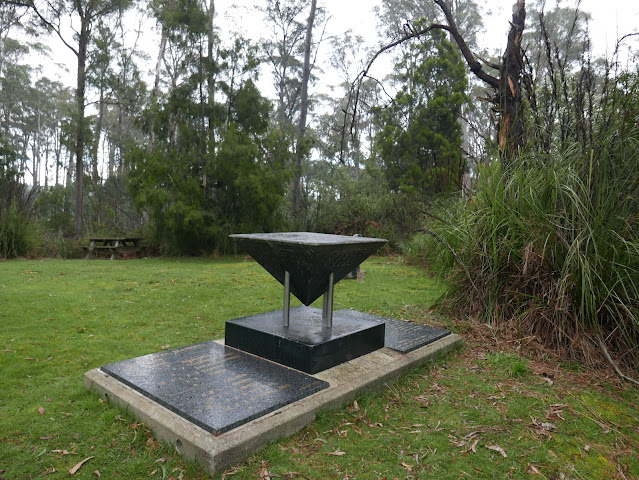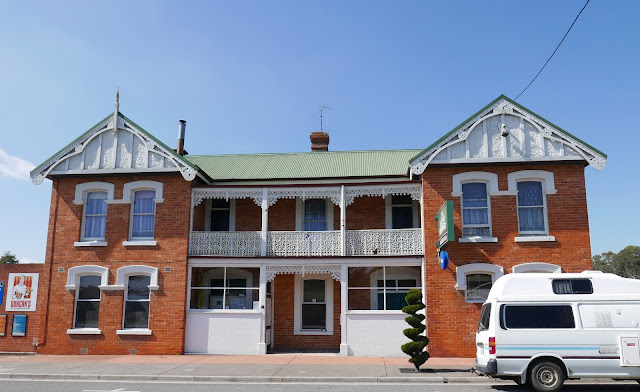 |
| Here's the answer, but what was the question? |
It was another early start and a grey and drizzly one at
that. It was a bit too early for the shops so I thought I would take a look at
Sykes Sanctuary first since it was only two km down Sunnyside Road on the Sheffield side. I’m pleased to
report that our normally very reliable Weather Service was wrong on this
occasion. As soon as I had started on some of the walking tracks the weather
brightened up considerably and the cryptic monuments were bathed in gold.
Sykes Sanctuary
 |
| Norman Sykes - Resident of Railton and early Conservationist |
This Photo by Gavin Bannerman is licensed under CC BY-NC-ND
Move over Henry David Thoreau. Norman Sykes (1896 -1981) whose
wooden statue stands at the entrance to Railton, was born in the UK and
migrated to Australia with his wife and two children in 1947. An engineer and a
World War I fighter pilot - also a musician and a philosopher, he eventually brought 40 acres of bushland in this area and called them his Sanctuary, In 1953, after his wife had died
and his children had flown the nest, Sykes moved here permanently having had "enough of war and civilisation" and wanting to live as close to nature as
possible.
An early conservationist, he dined on roadkill and regularly travelled to Devonport on his
bicycle which he also used to generate electricity for his reading lamp.
Apart from leaving his land and tools to the young people of Railton,
his most important legacy is the collection of symbols and inscriptions he
left behind for later generations to puzzle over. A 2013 Article in New Dawn states that the sculptures only began appearing between 2002 and 2003 several years after his death.
They are believed to be the work of Ian Sykes, one of Norman Sykes' sons who has sought to interpret his father's work. According to the younger Sykes, it is about showing a correlation between language, sound and numbers - a mathematical key to the universe, not unlike the quest for the Music of the Spheres which astronomers such as Kepler sought in the movement of the planets. Whatever the meaning of these symbols, they add an esoteric element to this rustic little corner of the world and are a fitting memorial to a man whose ideas were ahead of their time.
 |
| Another of the intriguing monuments at the Sanctuary |
There is a peaceful picnic area here and access to several tracks. One follows the path of the "Railton Rattler" – a former train service that ran from Mt. Roland and Sheffield from 1914 to 1957, and the other joins the Tasmanian Trail which caters to horse riders and cyclists and continues all the way to Sheffield. I walked along it for about 2 km accompanied first by birdsong, then a dogwalker and finally the sound of a chainsaw being used vigorously on a nearby farm. The country day had begun. I hurried back to Railton for a bite to eat and picked up a delicious raspberry custard crumble cake at the Limestone Café and Bakery to have with mid -morning coffee.
 |
| Small section of the Tasmanian Trail behind Sykes' Sanctuary, Railton. It is filled with birdsong |
 |
| The picnic tables and seats look inviting when the sun comes out |
Railton
Railton (pop. 1079) and 25 km from Devonport is a quiet, neat,
sprawling little town with enormously wide streets. Billing itself as the
Topiary Town, it seems that while the recent house -buying frenzy in Tasmania
has not passed it by, it has not been as intense here as in some other regions,
perhaps because it’s not on a major highway, nor on the road to Cradle
Mountain. Although the tiny Post Office and Gift store and the Bakery were busy, most
other shops were still closed.
 |
| Topiary Work in the Main Street. There's more in the side streets |
 |
| Another example |
Originally called Redwater Creek until the 1860s, Railton was
once a busy railhead for the timber industry, farm produce and cement, until
largely overtaken by road transport. However, you can see evidence
of its former glory in grand buildings like The King’s Hall and the two -storey hotel which dates from 1853 when the
region supplied timber for the Gold Rush building boom in Melbourne.
A sign tells me that its wide streets were to enable huge bullock teams to be able to turn around. The topiary work was originally the brainchild of one Neil Hurley, now deceased, who began it in 1999 though his work has since been carried on by others. There are now 154 such living sculptures around the town and local business have free maps so you can find them all.
 | |
| Railton's exceptionally wide streets make its shops look even smaller |
 | ||
| There are beautiful flowering trees here as well, nice clean facilities and and RV parking on the Esplanade |
 |
| I liked these bus shelters with their little sunshades - better than most of those in Hobart |
 |
| This mural commemorates the Cement Works, a mainstay of the town's economy since 1912 |
Railton's other claims to fame are the Seven Sheds Brewery, Meadery and Hop Garden located a little way out of town -still closed on this Monday morning, and its Mountain Bike Trails which, together
with those in Latrobe and Sheffield are collectively known as Wild Mersey. More about the Mountain Bike Trails next time.
 |
| Shades of former glory -The Railton Hotel dates from 1853 |
Comments